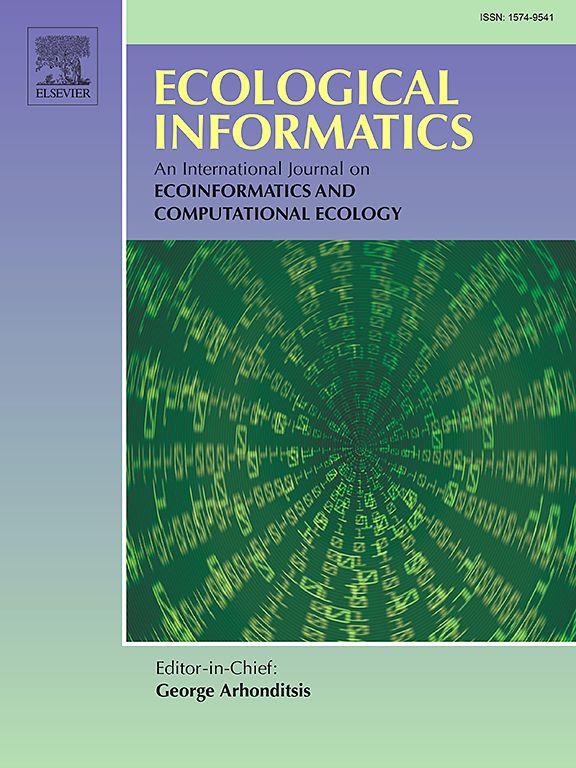Modeling time series of vegetation indices in tallgrass prairie using machine and deep learning algorithms
IF 7.3
2区 环境科学与生态学
Q1 ECOLOGY
引用次数: 0
Abstract
The vegetation phenology of tallgrass prairie varies yearly, depending on climatic conditions, plant species composition, and location. Modeling time series of vegetation indices (VIs) using climate data can be useful for understanding and predicting how tallgrass prairie will respond to future climate scenarios and for identifying and managing areas of tallgrass prairie that are particularly susceptible to climate-induced changes. Machine or deep learning algorithms can be well-suited to model VIs for phenology studies by identifying patterns and relationships between climatic factors and VIs using historical data. This study evaluated the performance of 12 machine and deep learning algorithms, encompassing a diverse range of algorithmic families, in modeling patterns of the Moderate Resolution Imaging Spectroradiometer-derived enhanced vegetation index (EVI, greenness index) and land surface water index (LSWI) in native tallgrass prairie. The models include linear regression, Bayesian ridge, elastic net, decision tree, random forest, eXtreme Gradient Boosting (XGBoost), support vector regression (SVR), K-nearest neighbors (KNN), artificial neural network (ANN), convolutional neural network (CNN), recurrent neural network (RNN), and long short-term memory (LSTM). Air and soil temperatures showed the highest correlations with EVI (r ≥ 0.77) and LSWI (r ≥ 0.56). The low correlation (r ≤ 0.23) of EVI and LSWI with contemporaneous rainfall or soil moisture suggests vegetation's delayed response to these factors. The results indicated that ensemble methods like XGBoost and random forest performed best across all three datasets (i.e., training, testing, and validation) for modeling EVI and LSWI. Deep learning models showed varying performance across datasets, and their performance was sub-optimal compared to XGBoost and random forest. The linear regression also showed a moderate performance, while the decision tree performed the weakest overall. The strong performance of XGBoost and random forest highlights the intricate and nonlinear relationship of prairie vegetation with climatic factors. These models' strength lies in capturing such complexities. This study provides insights into the key climatic factors and underlying processes that control the vegetation dynamics of tallgrass prairie ecosystems. Our machine learning models can be a valuable tool for developing new strategies to manage tallgrass prairie ecosystems in the face of climate change.
基于机器和深度学习算法的高草草原植被指数时间序列建模
高草草原的植被物候随气候条件、植物种类组成和地理位置的不同而逐年变化。利用气候数据对植被指数时间序列进行建模,有助于理解和预测高草草原对未来气候情景的响应,并有助于确定和管理特别容易受到气候变化影响的高草草原区域。机器或深度学习算法可以通过使用历史数据识别气候因素与VIs之间的模式和关系,非常适合为物候研究建立VIs模型。本研究评估了12种机器和深度学习算法的性能,这些算法涵盖了不同的算法族,用于模拟本地高草草原中分辨率成像光谱仪衍生的增强植被指数(EVI,绿度指数)和陆地地表水指数(LSWI)模式。模型包括线性回归、贝叶斯脊、弹性网络、决策树、随机森林、极限梯度增强(XGBoost)、支持向量回归(SVR)、k近邻(KNN)、人工神经网络(ANN)、卷积神经网络(CNN)、循环神经网络(RNN)和长短期记忆(LSTM)。空气和土壤温度与EVI (r≥0.77)和LSWI (r≥0.56)的相关性最高。EVI和LSWI与同期降雨量或土壤湿度的相关性较低(r≤0.23),表明植被对这些因素的响应滞后。结果表明,像XGBoost和随机森林这样的集成方法在所有三个数据集(即训练、测试和验证)上对EVI和LSWI建模效果最好。深度学习模型在不同的数据集表现出不同的性能,与XGBoost和随机森林相比,它们的性能不是最优的。线性回归也表现出中等的表现,而决策树总体表现最差。XGBoost和随机森林的强劲表现凸显了草原植被与气候因子之间复杂的非线性关系。这些模型的优势在于能够捕捉到这种复杂性。本研究揭示了控制高草草原生态系统植被动态的关键气候因子和潜在过程。面对气候变化,我们的机器学习模型可以成为开发新策略来管理高草草原生态系统的宝贵工具。
本文章由计算机程序翻译,如有差异,请以英文原文为准。
求助全文
约1分钟内获得全文
求助全文
来源期刊

Ecological Informatics
环境科学-生态学
CiteScore
8.30
自引率
11.80%
发文量
346
审稿时长
46 days
期刊介绍:
The journal Ecological Informatics is devoted to the publication of high quality, peer-reviewed articles on all aspects of computational ecology, data science and biogeography. The scope of the journal takes into account the data-intensive nature of ecology, the growing capacity of information technology to access, harness and leverage complex data as well as the critical need for informing sustainable management in view of global environmental and climate change.
The nature of the journal is interdisciplinary at the crossover between ecology and informatics. It focuses on novel concepts and techniques for image- and genome-based monitoring and interpretation, sensor- and multimedia-based data acquisition, internet-based data archiving and sharing, data assimilation, modelling and prediction of ecological data.
 求助内容:
求助内容: 应助结果提醒方式:
应助结果提醒方式:


